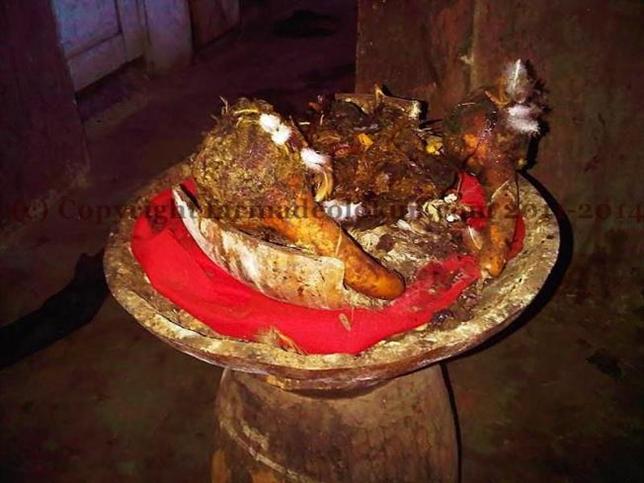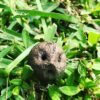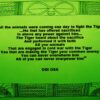Sango is one of the most well loved and charismatic of the orisa. Also known as arira, “light and fire that flashes here and there in the sky”, he is not to be mistaken as the son of Oranmiyan and the one time Alaafin of Oyo. It is very important to distinguish between irunmole and humans, who because of their feats and behavior in life, were elevated to irunmole status while alive. This myth of Sango the irunmole as the Alaafin of Oyo seems to be very prevalent in the diaspora but is soundly rejected in Yorubaland. Odu Ifa (Owonrin Wori) clearly state that any reference to Sango in the Kingdom of Oyo is due to the King of Oyo naming his two sons, Ajaka, and the other Sango, because of the latter’s character and powers similar to that of the ancient orisa Sango. There is a difference between humans who were given title as an orisa because of their feats during life, and the irunmole. Hardly anyone uses the word “orisa” in Yorubaland, they use irunmole when speaking of the forces which humans have anthropomorphized to call orisa. Ifa speaks in parables, and even when talking about which orisa had many “wives” and seemingly human endeavors, there is a deeper meaning if we look into the matter. There is a spiritual meaning beyond what our human mind wants to make fit so neatly with our own lives and social environment.
Sango is known as the Lord of Thunder, a master herbalist, and one who metes out Justice by means of the thunder and fire that he can blow from his mouth, and his use of the many thunder stones he throws to strike his enemies down. He dresses in a tunic and skirt of strips of cloth covered with cowrie shells in intricate designs and plaits his hair in the fashion of a woman. Many statues and icons are mistakenly thought in the diaspora to be those of female orisa when in fact they are depicting Sango with a bosom as he is also an orisa linked to fertility.
Sango’s nature is very masculine, straight forward, bold, confident, energetic, brilliant and confident. Children of Sango are usually very attractive, tall and slim limbed, adventurous and have little patience with slow thinkers. This is due to Sango being a brilliant strategist and tactician; a natural leader who rallies people around him. Magnetic, intelligent, Sango uses his talents to push strategies and plans through to a successful outcome. He is capable of succeeding in all matters of Justice and just as capable to relish the fruits of his conquests and victories after the battle is won.
Many praise oriki recite his virtues:
Ino loju, ino lenu: fire in the eyes and mouth.
Aa fi igba ita segun: One that won battle with 200 stones.
Onimu nsimu, eke nsa: Sango is working and the dishonest are nervous and fleeing.
Oloju orogbo, elereke obi: One that has eyes of bitter kola and cheeks of obi seeds.
Sango lomo aa ja maa jebi: Wherever and whenever Sango fights, judgment is always on his side
Ayanyan ino, akata yeriyeri: Light and flames that blow here and there.
Sango lo mewe , emi ko mewe: I do not know how to use herbs and leaves, but Sango knows very well)
Sango possesses both male and female devotees, and while in trance can eat fire, walk on coals, and carry a live brazier of coals on the head or place coals in their mouths. Sango is owner of the most spirited dancing and his leaps and high kicks are fantastic to watch as he dances to the very fast paced beat of his signature drumming.
Sango priests can be seen in Yorubaland performing feats of magic such as cutting the eyes, tongue, skin with a machete and within seconds the wound will stop bleeding and heal up before the eyes. They pierce the skin with needles, swords, nails, razors and suffer no permanent damage. Sango makes the human body impervious to injury while manifested and he is linked to the sacred Baobab tree which is also the only tree in the forest that can withstand fire and remain standing. Baobab tree bark, roots, leaves and fruit and its use in Ifa medicine/preparations is sacred to Sango and at the tree’s base after a thunderstorm, Sango’s edun ara ( a smooth stone shaped like an ax head), can often be found along with smaller thunder stones. Devotees search for these after thunderstorms to use in their devotion and for protection.
Sango was historically married to Oya, the river orisa, who rises up to create rain drenched wind storms and tempests, and some say it was actually she who gave the power of fire to Sango. What is certain is that wherever Oya arrives, Sango soon follows. He is a strict enforcer of justice and detests liars, thieves, dishonesty and insincerity. The children of Sango are also very astute in the judgement of character and do not tolerate liars, will fight passionately to defend those who are wronged, and take vengeance on those of bad action and character. They must always strive to those ideals of honesty and truth.
Some of the symbols of Sango are his two headed axe, or ose, and this is always in his shrine along with an upturned mortar, the edun ara on a clay plate covered with palm oil and many small stones which are used to fight enemies. His colors are red, white and some black, the cloth is usually always elaborately covered with cowrie shells. There can be bata drums and there is always a seere, a small gourd which is used in the shrine offerings and its larger cousin can also be used as a musical instrument when covered with a net of beads called a shekere, in the diaspora. The seere gourd has a long history with Sango and you will never find one without the other.
The Story of Sango and the Seere
A verse from Oyeku Rete says:
…Adifafun sere ti o fe Igbadun leyin Sango Thus declared Ifa oracle to Seere that wanted to pair up with Sango.
Seere is the one that announced the arrival of Sango to the townspeople, just as the Oba’s messenger who runs before the arrival of the King, that Sango would soon be coming to help the people solve their physical and spiritual problems and afflictions, as well as pray for their material needs. After Seere’s announcement, Sango would appear and immediately solve their problems. He performed as a physician using herbs and leaves (contained in the magical Seere) as well as foreseeing and predicting the future. Almost all of the people would give them money, fine cloth and many other gifts for assisting them overcome their troubles. When Sango and Seere reached their home one day to divide their gifts, Sango said that he would take the larger share, simply because he was the doctor attending to the people, while Seere only summoned for them. Seere rejected the notion and said they were full partners so they should either share the gifts equally or they should split up. Both of them agreed to dissolve their partnership and went their separate ways. Then, whenever each of them went out to work alone, people said, “this is not the real Seere! The Seere we know announces the arrival of Sango!”. The same happened when Sango went out, people said, “the coming of the real Sango we know is always announced by Seere!”. So both starved and they didn’t receive any food, gifts, or money as recognition from the people. Unbeknownst to each other they now separately went to consult the Ifa oracle. Ifa then revealed to them that they should settle the dispute that had arisen between them so they can have progress in life. They became partners again and Seere continued to announce the arrival of Sango and contain his ewe, leaves for Ifa medicine (ewe oogun). It is for this reason that since that day Seere the gourd is always found in most shrines next to the ota of Sango.
© 2016 by Farin da Silva, All Rights Reserved. Pursuant to the Copyright Act of 1976 and subsequent amendments, codified as 17 U.S.C. §§ 101-810, the works contained within are protected by United States laws and by international treaties. This includes the literary and pictorial works created by Farin da Silva contained herein, as well as any other original works of authorship fixed in any tangible medium of expression. The unauthorized copying, distributing, displaying, or production of derivative works is strictly prohibited by Farin da Silva. Copyright infringement may subject you to civil liability of a minimum of $750 per infringement for statutory damages, as well as the costs incurred to enforce these rights. 17 U.S.C. § 504. A court may award up to $150,000 per infringement. This copyright holder takes copyright infringement seriously and does enforce their rights.
Photo and copyright courtesy of Baba Akin Alapo Opele





